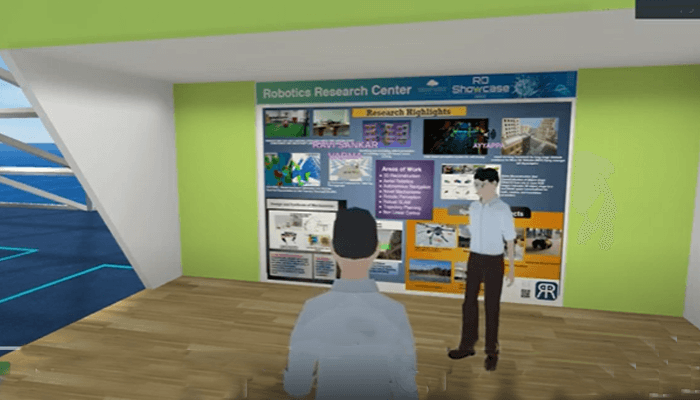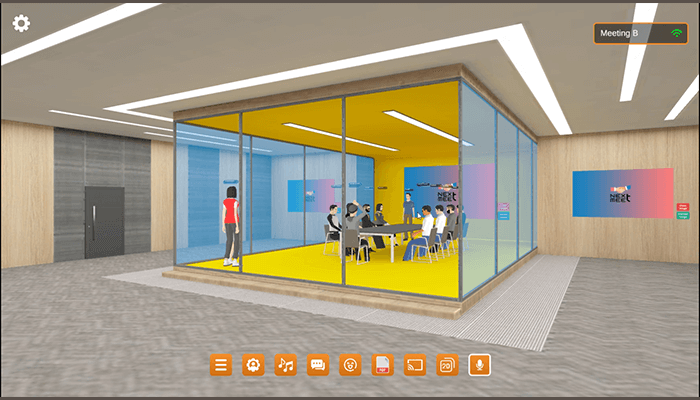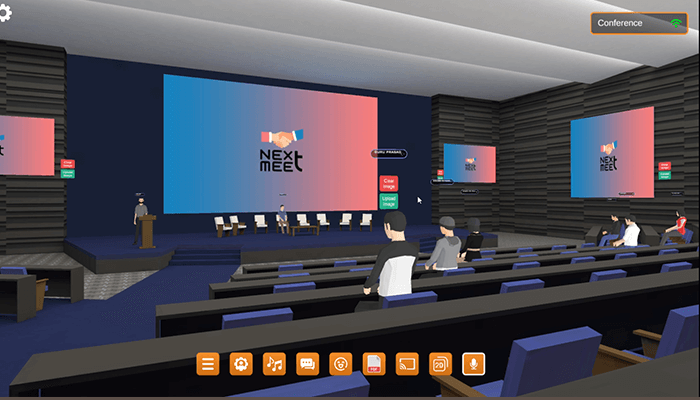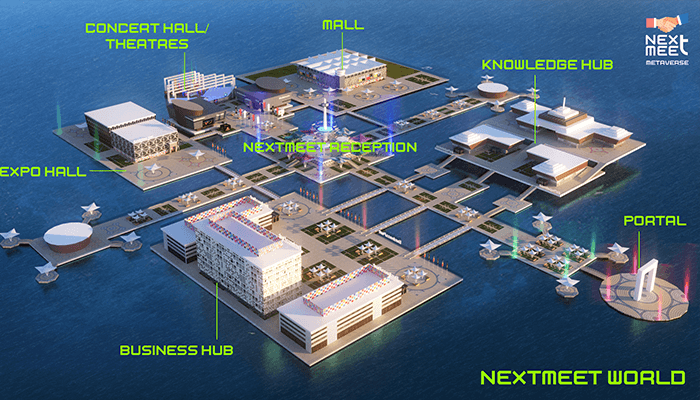Zoom events were de rigueur in 2020. But now instead of passively sitting in front of a screen, you can actually mingle in the Metaverse. IIITH’s R&D Showcase 2022 showed us just how that was possible, thanks to CIE-based startup NextMeet.
When Ravi Sankar Nadimpalli, BYJU’s FutureSchool heard about the multi-model form adopted by IIITH for it’s annual R&D showcase, he – like many others – was suitably intrigued. After a 2-year pandemic-enforced gap, the institute had announced the return of its flagship event, albeit in a hybrid mode. “In 2020, we had to call it off at the last minute even before the lockdown was in place due to rising Covid-19 cases. Then last year, we conducted it in a virtual format by hosting the research demos and brief video presentations on the portal. This year, with things easing up, we decided to try the hybrid approach – a combination of the physical event where select industry folks were invited, the online portal and also in the Metaverse, where everyone else could attend,” remarks Prof. Ramesh Loganathan. The idea behind simultaneously showcasing the institute’s research progress in the Metaverse was drawn from NextMeet, a CIE-based startup that had been conducting events in virtual reality through its 3D platform.

The Future Is Here
The Metaverse, touted as the technology of the future, is more often than not misunderstood. This alternate reality where people can work, play, socialise or just chill owes its genesis to the gaming industry. However, unlike popular perception, not all of these digital spaces are 3D immersive requiring sophisticated AR and VR equipment. For instance, though NextMeet’s platform includes a VR version, the absence of a VR headset is not a deal breaker. “Have you ever tried the VR experience?”, asks Pushpak Kypuram, CEO of the startup. “I personally don’t like wearing a headset for more than 5 minutes. It’s bulky and quite a pain, apart from being expensive.” In addition to this, he points out that access to such equipment is currently available online only and not at retail outlets yet. So how does Next.Meet work then? Their Metaverse platform is easily accessible via Windows, a laptop or a mobile device, where participants can choose an avatar before diving into a designated space.

As Real As It Gets
“At the end of the day, the online version is still a website. We wanted everything to be visible and stay true to a ‘showcase’”, says Ramesh referring to the R&D event. With the actual event simulated virtually, visitors to the expo could access it via a link on either the laptop or a phone. Spread over two halls, the showcase boasted of 17 big booths displaying 600 research papers manned by student avatars. Nadimpalli was delighted to find that he could not only walk up to any stall of his choice just by moving the arrow keys, but also engage in a conversation with the student researchers there. Virtual participants were also privy to the keynote address by Vinod K Nandicoori, Director, CCMB thanks to its broadcast into the 3D environment. “Unlike just watching a video of the address, there was a feel of being in an auditorium seated with many others. Besides, if you knew anyone else present there, you could ‘sit’ next to that person and have a conversation in the hall giving the vibes of actually attending the event in real,” explains Pushpak.
Workplace Solution
NextMeet’s association with CIE began with its selection via the Avishkar accelerator – a program that targets deep tech startups. Their solution includes immersive 3D environments that are a fit for workplaces, conferences, product launches, training programmes, educational events, and entertainment. With a team comprising 20-odd people scattered all over India “from Kerala to Andhra Pradesh and Telangana to Tamil Nadu and the foothills of the Himalayas”, they are a real-life advertisement of their own virtual workplace solution, using it to stay connected and engaged. “I endorse virtual wherever possible,” exclaims Pushpak, adding, “If one could get splendid views of the Himalayan mountain ranges and the next minute, don an avatar to walk in and out of an ‘office’, meet in a huddle room and even indulge in the proverbial water cooler talk – all virtually, then why not?” Despite a large number of companies issuing a return-to-office mandate, there’s an equal number whose employees who have permanently opted for a hybrid or a remote working arrangement. For them, unlike connecting over a 2D interface like Zoom, interactive workplace environments in 3D help in quelling UI fatigue and disconnectedness.

Industry-Agnostic
For educational institutes too who have gone on to adopt the hybrid model of learning, a Metaverse-based platform is ideal. However, it’s not just lectures or classes that students can attend virtually, but extra-curricular activities too. “Every university has clubs of some sort – cultural or tech-based. To host physical meetups of such clubs requires physical space such as a conference room, and then there are budgetary issues if it needs to be hired, provision of other logistics and so on,” observes Pushpak, driving home the point about it being easier in the virtual world. Besides universities, NextMeet has clients drawn from various industries and sectors such as the auto industry, hospitality and healthcare too. “We have a sizeable number of international clients in the mix who want to have custom built environments for them,” says Pushpak. The Metaverse with its high level of interactivity and 3D displays checks all the right boxes for skill development and training purposes. “A lot of companies such as those in the vehicle or aircraft maintenance industry make their employees undergo training inside the virtual environment. If they have a facility say, in Australia or someplace else, they don’t have to create another workshop in India. They could just have a digital replica or a 3D twin of the same on our platform.”

Drawn To Animate
Pushpak’s tryst with animation and simulation began way back in 1999. A graduate of Biology from Nizam’s College, Hyderabad, he instead found himself drawn toward 3D animation and multimedia, eventually enrolling in a formal course to learn more about it. A career which initially began in 3D animation for realty expanded to include the education and media industry. In 2015, he met Prashant Chandra when the buzz about AR/VR started growing louder. Together, they founded AffinityVR which integrated 3D experiences in AR and VR. Prashant brings onboard 18+ years of medical and e-learning experience. “In 2019, we realised that there was a clamour for virtual reality collaboration. It wasn’t enough that people were watching or were present in a 3D environment, they now wanted to collaborate and talk with each other,” says Pushpak. With Dr. Linda Nubai, an architect and professor at Michigan State University with more than 2 decades of experience in 3D and multimedia, joining in first as an investor and then as cofounder, the trio decided to use their collective experience in creating a 3D experiential platform. Thus NextMeet was officially launched in October 2020.

Like most startups, Pushpak states that they were bootstrapped until August 2021 when they received funding from an angel investor to the tune of 50 lakhs. Last month, they again raised $200K from Sudhakar Reddy Chirra, CEO and Founder of Abhibus. “When the product – currently in beta – is out, we will need the funds to expand our support teams such as the sales and marketing operations,” he says.

What Next?
With a growing interest in virtual reality, NextMeet will soon allow event organisers to customise their own spaces. “We are launching a D-I-Y platform where essentially the owner of the event can start the application, create a session, invite and manage people into that session, design the venue using 3D design tools, change images and banners associated with it and so on,” says Pushpak. Speaking of how hybrid events are here to stay for some time, Ramesh says, “Nobody’s swinging away completely to a physical presence anytime soon. So that is the opportunity for the NextMeet team”. Lauding them for their lightweight technology and extremely responsive UI, he expresses optimism about having a mixed reality event in the future with an immersive blend of the physical world with the digital, “if they introduce it by then”. Calling themselves a “product ready company with paying customers”, Pushpak believes that the products should do all the talking. For now, 100% Metaverse is where they want to eventually be. “The first step is to make sure the 3D experiential platform is enabled without any hassles. The next step would be to get into the decentralisation of tokens and NFTs. With the 3D and decentralised finance experience coming together, we are going toward creating the largest Metaverse in India.”




Next post